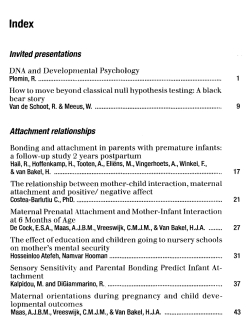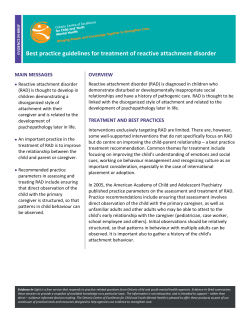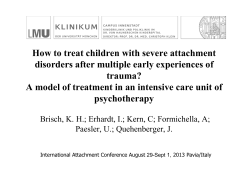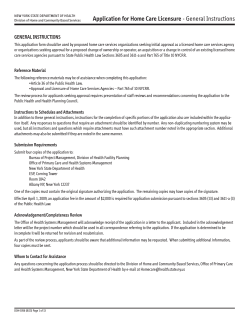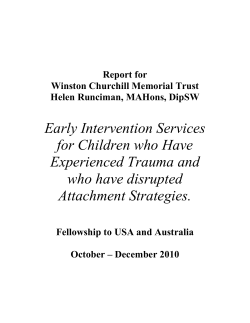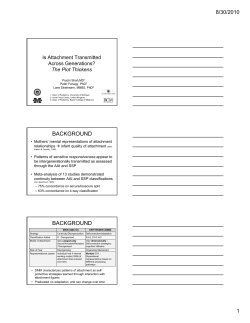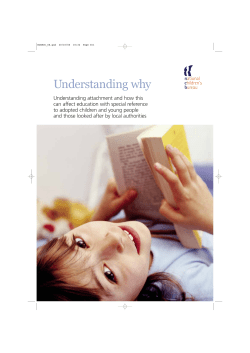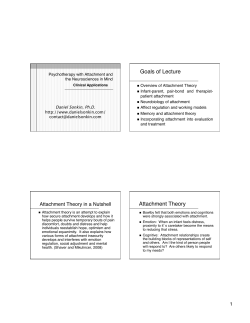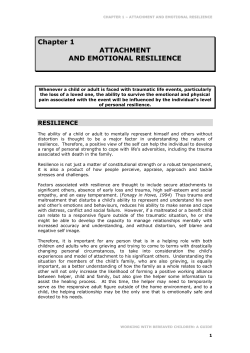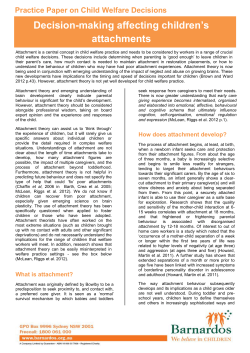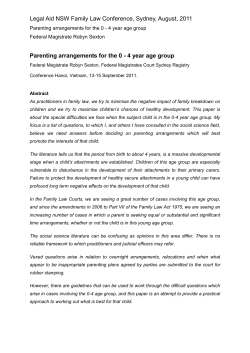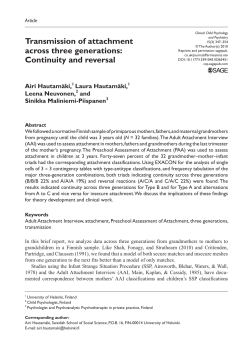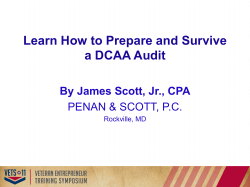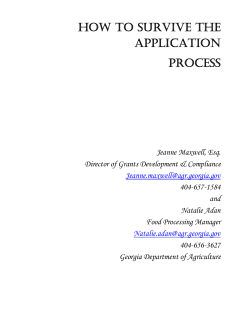
AttAchment in Adoption
Attachment in adoption Focus on the Family would like to thank Dr. Karyn Purvis and the TCU Institute of Child Development. The content in this booklet is derived or reproduced in part from Trust-Based Relational Intervention® resources (Purvis & Cross, 1999-2011) and used with permission of the TCU Institute of Child Development. When emotional, psychological, behavioral or learning difficulties arise with children who were adopted or in foster care—especially children with a history of neglect or abuse—the problem is nearly always rooted in or related to issues of attachment. That’s because kids from hard places tend to be disconnected kids. In negotiating conflicts and impasses with these children, parents need to understand that the ultimate goal is to draw them into a circle of safety and security, disarm their defenses and help them reconnect. Definition. For our purposes, attachment can be defined as an inborn system in the brain that influences and organizes motivational, emotional and memory processes with respect to significant care-giving figures. It’s the ability to connect with other human beings. The functionality of this system is dependent upon a child’s “affective attunement” to the parent and the establishment of a secure emotional base. Without this base, the development of normal behavior patterns is short-circuited, and a child’s ability to relate to others in normal, healthy ways is hindered. how attachment develops. Under ideal conditions, attachment springs up and grows within the context of nurturing experiences with a loving caregiver. Early interpersonal contacts have a profound impact upon the brain. As a nursing child snuggles close to her mother’s breast, looks up into her mother’s eyes and sees her own expression mirrored in her mother’s face, her central nervous system forms synapses associated with these sensory images and envelops them in a network of positive neurochemical links. If these positive experiences are lacking, or if a child’s interactions with a primary caregiver are frightening or traumatic, chronically elevated levels of stress-related hormones, such as cortisol, can cause significant damage to the limbic system of the brain and impair a child’s capacity for secure and meaningful human relationships. Foundations: THE STAGES OF INFANT ATTACHMENT. The process by which babies form secure emotional attachments with caregivers unfolds in three stages: • Indiscriminate social responsiveness (0 to 2 months). At this early stage of development, a child will focus with pleasure on any human face. • Discriminate social responsiveness (2 to 7 months). During this phase babies begin to discriminate and show a preference for familiar faces. • Specific attachment relationships (7 to 30 months). From this point forward complex attachment behaviors begin to emerge and develop as a child gains increased mobility. He will seek proximity to a preferred caregiver and try to maintain contact once it’s achieved. The most critical age for attachment is reached at about 7 months, and the period from 6 to 12 months represents a delicate window within which a child’s ability to form healthy connections can be curtailed if conditions for its growth are less than ideal. (Note: A child who is moved into a new situation can form positive attachments if the change takes place by seven to eight months of age. If the shift happens later, the parent will need to be more attentive to attachment issues in order to avoid later attachment problems.) parents need to understand that the ultimate goal is to draw Children into a circle of safety. Abilities Required for Attachment. According to Dr. Jude Cassidy of the Maryland Child and Family Development Lab (University of Maryland, College Park), there are four abilities required for the development of intimacy between human beings. All of these abilities are facilitated by secure attachment: • The ability to seek care. A person cannot learn to be intimate with anyone unless he is willing and able to turn to others—appropriately selected others—in times of trouble. This involves trust and a certain amount of self-confidence—confidence that the self is both lovable and worthy of care. •The ability to give care. Interestingly enough, an individual’s sense of security is to a large degree associated with his or her ability to care for others. Naturally, this ability develops largely within a context of having been cared for. • The ability to feel comfortable with an autonomous self. Ironic as it sounds, independence is a prerequisite for intimacy. For genuine attachment to exist, it’s necessary that there should first be two separate, autonomous persons who are willing to make contact and honor respective differences. Each must be free of the fear of being “engulfed” or dominated by the other. • The ability to negotiate. Healthy relationships have been described as “goal-corrected partnerships.” In a parent-child relationship, productive negotiation takes place when the child knows that his wishes and preferences will be heard, understood and acknowledged, and that he will get what he wants some of the time. Under ideal circumstances, this ability is shaped within the context of a healthy mother-infant relationship. Four Attachment Styles. Using an experiment dubbed “Strange Situation” in which a baby is left with a stranger for a brief period of time before being retrieved by his or her mother, researcher Mary Ainsworth has identified four categories of infant attachment styles. Data collected by way of the Adult Attachment Interview (AAI) has revealed that the same four classifications can be used to characterize adult attachment styles, though the names differ slightly in each case. The categories are as follows: •Secure (Adult: Free/Autonomous). A secure infant seeks to be near the parent, is easily consoled by the presence of a caregiver and quickly returns to play once the stress of the “strange situation” has been resolved. Individuals who carry this attachment style into adulthood are comfortable with their own autonomy and independence and find it easy to free themselves from the need to expend energy managing past disappointments and hurts. A child’s sense of security is the direct result of parental responsiveness, affection, sensitivity and acknowledgment of the child’s wants and needs in both actions and words. Secure infants grow up to be more sociable, more cooperative with peers and better able to maintain enthusiasm and energy for challenging tasks than their insecure counterparts. • Insecure/Ambivalent (Adult: Entangled). An ambivalent child is the product of inconsistent parental care. His clingy, hypervigilant, “push/pull” method of relating to his mother reflects the “on-again, off-again” character of her attentions and affections. When she re-enters the room, he whines, cries and holds on to her for the simple reason that he never knows when she might go away again. Ambivalent babies become entangled adults—those who can never let go of the abuses and betrayals of past relationships. disorganized adults—candidates for addiction, dissociative behaviors and borderline personality disorders. • Insecure/Avoidant (Adult: Dismissing). The avoidant infant shows little or no desire to be held or comforted by his mother. He ignores her and pretends to be occupied with toys or other interests when she re-enters the room, though inwardly he is filled with anxiety and stress. His behavior is a defense mechanism designed to protect him against the pain of being rejected by a cold, non-nurturing or abusive parent. In adulthood, avoidance expresses itself as dismissal or denial—an unwillingness to deal with or even acknowledge past or present relational difficulties. It’s also crucial to add that, according to several reputable studies, percentages of entangled, dismissing or unresolved adults tend to be much higher among parents of troubled adoptions than we would expect to find in the population at large. In some cases 25 percent of these moms and dads have tested out as unresolved as opposed to a mere 2 percent in the general population. Here is cause for special concern. These statistics indicate that parents of kids from hard places need to be careful and diligent about working on their own attachment issues before attempting to solve the problems they’re facing with their children. It stands to reason that we can’t raise secure kids until we are secure enough to meet their needs and make ourselves available to them in the present moment. • Insecure/Disorganized or Disoriented (Adult: Unresolved or Disorganized). A child with a disorganized attachment style displays a variety of unusual and even bizarre behaviors when he becomes aware of his mother’s return. He is hypervigilant and thus unable to play. He may “zone out,” slip into a trance-like state or engage in strange repetitive behaviors such as rocking back and forth or pawing the air. Such reactions to the mother’s presence are expressions of confusion and pure terror and are generally regarded as evidence of parental abuse. In later life, disorganized children grow into Of vital importance to parents of every description, but especially those who are raising children who were adopted or in foster care, is the fact that attachment styles tend to be transmitted wholesale from one generation to the next. In other words, avoidant parents tend to raise avoidant children. Addressing the Issue. Here, as in almost every area of parenting kids from hard places, the bad news and the good news are the same: the human brain is plastic, and as a result it can always reorganize itself, whether to deal with danger and trauma or to adapt to a new environment of safety and trust. This message applies to moms and dads as well as to kids. Broken relationships can heal. Intergenerational transmission of under ideal circumstances, the human brain requires three years of mentoring to develop normal sensory processing. unhealthy attachment styles can be reversed. It’s never too late to become connected in a healthy way. Individuals who didn’t start out as secure can become “earned secure.” It just takes diligence, determination and hard work on the part of the parent who wants to see it happen. Here are some thoughts and suggestions to get you moving in the right direction: • First, learn to recognize the signs of attachment disorder. Does your child avoid eye contact or refuse to be touched? Is he immature in his language and social skills? Does he comply with your wishes only when he wants something? All these behaviors are typical of a disconnected child. If you’re fairly new to adoption or fostering, be aware of the risk factors from your child’s past that may be influencing his present behavior. There are six to keep in mind: 1. Stressful pregnancy 4. Abuse 2. Difficult birth 5. Neglect 3. Early hospitalization 6. Trauma • Second, understand the importance of taking a holistic approach. Attachment can be retrieved, but the process must take the whole child into account and move forward by way of a complete restructuring of his environment. In particular, it should be based on a developmental model. A well-known axiom in the field of child development maintains that “recovery of function recapitulates development of function.” In other words, we can make up for the damage done during a child’s early years by starting over at the beginning and “re-doing” the entire developmental process. Even under ideal circumstances, the human brain requires three years of mentoring to develop normal sensory processing. Parents of disconnected kids should expect to invest a comparable amount of time in the task of bringing their at-risk children back “online.” • In connection with this last point, it’s crucial to remember that healing comes from deep, intuitive insight into the child’s early experiences and a patient, painstaking reversal of their negative effects. Give yourself and your child time to grieve and face up to the pain of the past. Become a good listener. Allow her to tell her own story—don’t tell it for her. Find creative ways to help her express her feelings. For example, you can facilitate her narrative skills by encouraging her to draw pictures representing her personal history or to act it out in puppet play. • You should also seek out the services of a professional therapist. Studies indicate that without effective treatment, children with attachment disorder and complex trauma become more symptomatic with the passage of time. In such cases, family therapy is generally more effective than individual treatment, so choose a therapist who specializes in attachment issues and who makes a point of working with parent and child together. • Therapy sessions should only be a jumping-off point for the work you’ll be doing with your child at home. In between visits with the counselor you can advance the healing process by developing “rituals of attachment.” Bedtime and mealtime routines fall into this category, as do simple little verbal exchanges such as, “Okay?” “Okay.” “Fair enough?” “Fair enough.” “See you later, Alligator.” “After ‘while, Crocodile.” Use sensory information, such as a smile, a soothing tone of voice or a gentle touch (always with the child’s permission) to communicate your love. This kind of playful interaction and light-hearted repartee is what Dr. Karyn Purvis calls “the Attachment Dance.” Like any dance, it’s more an art than a science, and it won’t work unless you enter into it in an atmosphere of disarming freedom and fun. • Since attachment problems are to a significant extent related to neurochemical imbalances in the brain—for example, low serotonin levels or an overabundance of stress hormones such as cortisol—it’s possible that a nutritional approach that includes a dietary plan or a regimen of appropriate supplements may help regulate your child’s mental and emotional state. But be careful not to “shotgun” supplements. Many high-risk children have suffered a form of “brain damage” or “neurological insult” as a result of early trauma, and their atrophied nervous systems are incapable of accommodating a sudden influx of serotonin (which, in some cases may actually be transformed into dopamine and lead to aberrant behavior). Remember that vitamins and drug therapies should at most account for only a very small portion of your treatment plan— perhaps 20 percent or less. The rest is a matter of behavioral intervention and personal interaction between parent and child. •Finally, always bear in mind that attachment is all about truth and that intimacy is directly connected to the feeling of being understood. Make a concerted effort to be honest and straightforward in all your dealings with your children and encourage them to do the same. Foster trust by cultivating an atmosphere of acceptance and openness. Let your children know in every way you can that they are loved with an unconditional love. If you need help locating a trained Christian counselor who specializes in family attachment therapy, your family pediatrician may be able to recommend a suitable practitioner. If not, Focus on the Family’s Counseling Department can provide referrals to qualified individuals practicing in your area—feel free to call us Monday through Friday between 6:00 a.m. and 8:00 p.m. Mountain time at 800-A-FAMILY (232-6459). You may also be able to find the resources you need by visiting the website of TCU Institute of Child Development [www.child.tcu.edu]. Sources Recommended Resources Some information from Trust-Based Relational Intervention Deborah D. Gray, Attaching in Adoption: Practical Tools for presentation (Purvis, Cross 1999). Resources and materials used Today’s Parents | Daniel A. Hughes, Facilitating Developmental with permission of TCU Institute of Child Development. | Karyn Attachment: The Road to Emotional Recovery and Behavioral B. Purvis, Ph.D., David R. Cross, Ph.D. and Wendy Lyons Change in Foster and Adopted Children | Karyn Purvis, Ph.D., Sunshine, The Connected Child | Karyn B. Purvis, Ph.D., The Empowering, Connecting, and Correcting Principles DVD | Karyn Attachment Dance (TCU Institute of Child Development) | Purvis, Ph.D., Playful Interaction DVD (TCU Institute of Child Arthur Becker-Weidman, Ph. D., “Effects of Early Maltreatment Development) | David Sanford, Handbook on Thriving as an on Development: A Descriptive Study Using the Vineland Adoptive Family: Real Life Solutions to Common Challenges | Adaptive Behavior Scales-II” Child Welfare League of America | Jayne E. Schooler & Thomas Atwood, The Whole Life Adoption Jude Cassidy, “Truth, Lies, and Intimacy: An Attachment Book: Realistic Advice for Building a Healthy Adoptive Family Perspective” Attachment & Human Development, 3, 2, 121-155 Let your children know in every way you can that they are loved with an unconditional love. iCareAboutOrphans.org 800-A-FAMILY (232-6459) © 2012 Focus on the Family 5022367
© Copyright 2025



